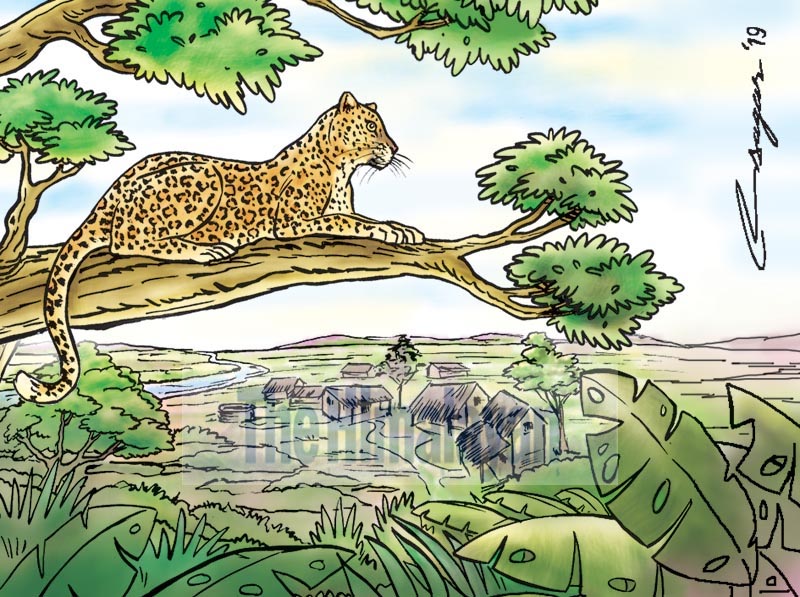Human-leopard conflict: Ecological reasons to blame
Many think that the frequency in the sightings of leopards in settlement areas is due to an increase in their number in the country. But those working closely in the conservation arena have a different view
Human-wildlife conflicts are a serious challenge for biodiversity conservation. These challenges are also increasing in Nepal with increased incidents of negative interactions with humans. Damage caused to houses by wild elephants, crop raids by different species of monkeys, wild boar and chital, and attack on livestock by tigers, leopards, wolves and snow leopards are a few examples. Besides, both wild animals and humans are either badly injured or have lost their life in some of those interactions.
Cases of human-leopard conflict are suspected to have risen recently. But we have limited information to support the claim. One thing is sure, reports of human-leopard conflicts are growing, which might be due to increased information access or increase in the conflicts themselves. Whatever the cause, human-leopard conflicts are threatening the survival of this vulnerable carnivore in Nepal. Top carnivores have a special role to play in the trophic level due to their influence in regulating the food web. This justifies the function of leopards in the ecosystems of Nepal as they are the top carnivores in the mountain ecosystems. Loss of leopard populations in the region would invite a host of problems, challenging our very life support system.
According to a study done in India, leopards at the Sanjay Gandhi National Park have been shown to regulate the number of stray dogs in Mumbai, saving thousands of lives from rabies. Despite their importance to humanity, leopards receive insufficient attention from the stakeholders. We do not have sufficient information about the distribution, population structure and dynamics of these predators in Nepal, thus preventing effective conservation interventions of this species. The common leopard is found in all three ecological belts of Nepal. In a study, Professors Karan Bahadur Shah and Tej Bahadur Thapa (2003), reported leopards from the then 73 out of the 75 districts. They are well reported from human-modified ecosystems, including the core areas of the Kathmandu Valley. But their high adaptability in nature has turned into a curse in many instances. As many as 51 leopards lost their lives due to humans from 2006 to 2012.
Leopards are also causing great financial loss due to destruction of livestock. Many people are also getting killed or are badly injured in leopard attacks. Leopards are killed when human society faces real or apparent threats from them. Despite reports of a rise in human-leopard conflicts, no proper intervention has been made to solve these problems that can be highlighted from the case of Bhanu Municipality of Tanahun in west Nepal, where in two separate incidents in 2018, two children were killed by a leopard. A search operation using a camera trap and other methods were initiated. Later on, a leopard, suspected to be a man-eater, was found dead, but the reasons behind the death remain unknown. Everybody soon forgot the incident. But last month, nine-year-old Puspa Adhikari was killed in a leopard attack in the same area.
The root causes behind human-leopard conflicts are ecological. Many think that the frequency in the sightings of leopards in settlement areas is due to an increase in their number in the country. But those working closely in the conservation arena have a different view. They suspect that the leopard population is rather dwindling. Hunger is one of the factors driving leopards towards settlements. In the case of protected areas in the Tarai region of Nepal, either the tiger population is increasing (as in the case of Bardia National Park) or the prey base is declining, forcing leopards to inhabit the low quality habitats outside the protected areas and venture into the settlements.
Besides, the forest area in Nepal has increased to almost 45 per cent primarily due to the community forestry programme. These forests provide excellent cover for the movement of leopards, but they are as good as green deserts as they support very low density of the prey species of leopards. Leopards are reported to be capable of covering nearly 20 km in a single night in search of their prey. As a result, leopards might be using the community forests as a cover to enter settlements in search of food. Undoubtedly, community forests have been successful in enhancing the forest cover, but their role in supporting biodiversity conservation, for example the prey base, to the roaming big cats is questionable.
The dependence of the leopards on domestic animals is shown by the presence of hair remains of stray dogs in the leopard’s scat samples from the Kathmandu Valley. Thus, these dogs could be the primary factors driving the leopards towards settlements. These dogs are easier to capture and requires less effort compared to catching wild prey. The leopards entering the settlement in search of dogs also attack livestock and humans.
The population dynamics of the tiger in the Tarai and the prey base, degradation of the habitats and increase in the population of stray dogs along with the expansion of forest cover provide plausible explanations about the drivers of human-leopard conflict. Targeted studies in detail and conservation interventions are essential to prevent conflicts between humans and leopards from escalating. Otherwise, the problem will continue to grow in the future, and both leopards and humans will suffer.
Aryal is a researcher with Environment Protection and Study Centre






